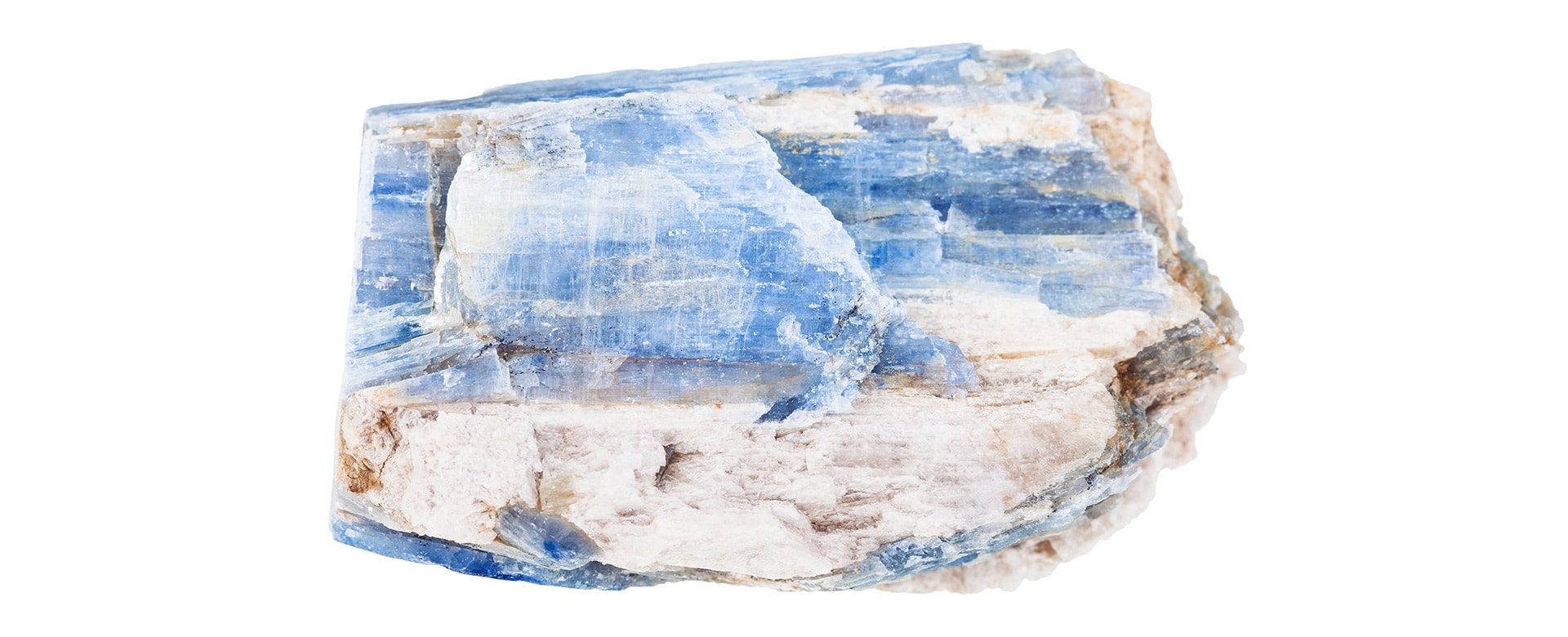Article Highlights
- Kyanite is a unique and striking blue aluminosilicate mineral that can tell us a lot about the geological conditions under which it was formed.
- One of the defining characteristics of kyanite is its strong anisotropism – a unique feature that means its hardness changes based on its crystallographic direction.
- The presence of kyanite in metamorphic rocks is an indicator of deep crust metamorphism, and it plays an essential role in geology as an index mineral.
- The vivid blue of kyanite comes from the Ancient Greek word ‘kuanos,’ meaning dark blue, adding a touch of history to its name.
- Beyond its aesthetic and historical value, kyanite has practical uses in the manufacturing of ceramics and abrasives.
If you’ve ever been lucky enough to stumble upon a piece of kyanite, it’s an experience that sticks with you. This beautiful blue aluminosilicate mineral, often found nestled within aluminium-rich metamorphic pegmatites and sedimentary rocks, is known for its vibrant, electric blue color that shines as bright as the summer sky.
But there’s more to this gem than meets the eye. One of kyanite’s most distinctive features is its strong anisotropism. Imagine a diamond, traditionally praised for its hardness, yet with a variable hardness depending on which direction you scratch. That’s what you get with kyanite, an oddity that sets it apart from most minerals out there.
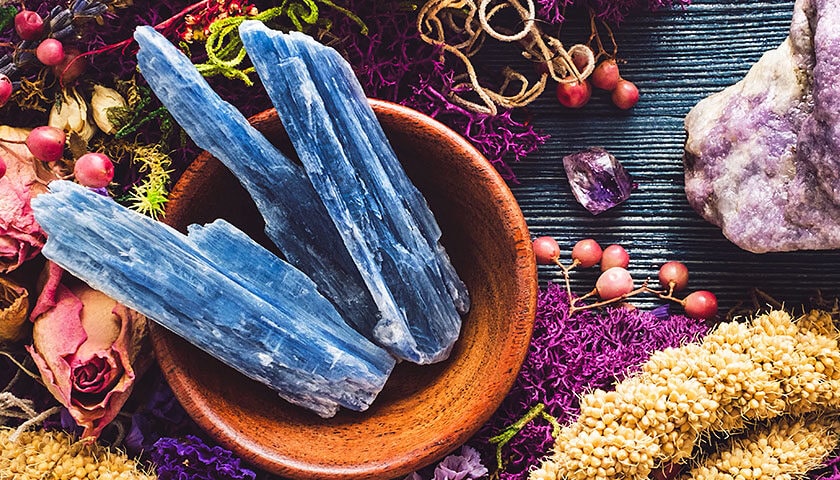
This peculiar characteristic isn’t just a novelty, though. It’s actually a handy identifying feature for geologists. After all, how many other minerals can say their hardness depends on their orientation?
The discovery of kyanite dates back to 1789, credited to Abraham Gottlieb Werner. Its name is derived from the Ancient Greek word ‘κύανος,’ typically rendered into English as ‘kuanos,’ which means “dark blue.” This connection with ancient history lends a certain timeless charm to the mineral.
The Geological Story of Kyanite
So, where does kyanite come from? It’s not just about where it’s found, but how it forms that tells the real story.
Kyanite tends to occur in specific types of metamorphic rocks such as biotite gneiss, mica schist, and hornfels. These rocks form under high pressure during regional metamorphism of a protolith, a precursor rock rich in aluminium. You might also occasionally stumble upon kyanite in granite and pegmatites, and even in associated quartz veins.
While kyanite’s home is within metamorphic rocks, it’s also an intrepid traveler. You can find it as detrital grains within sedimentary rocks, carried by rivers and other natural processes. However, it’s somewhat of a fleeting guest in these settings as it tends to weather rapidly.
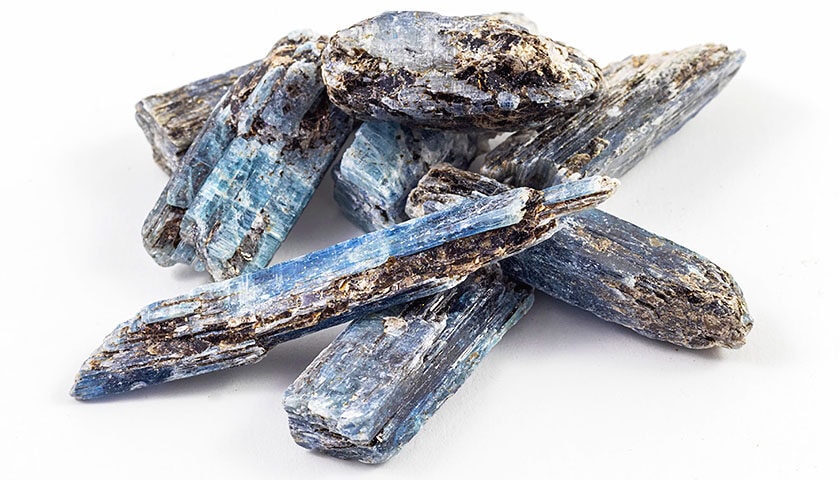
What makes kyanite even more interesting is its familial ties to other minerals. Kyanite belongs to a family of minerals known as polymorphs, which are minerals with identical compositions but a different, distinct crystal structure. Kyanite has two siblings in this family: andalusite and sillimanite.
Now, here’s where it gets really interesting. Kyanite, andalusite, and sillimanite all have their preferred living conditions. Kyanite is a bit of a high-pressure type, favoring stability under the intense conditions found deep in the Earth. Andalusite is a bit more laid back, preferring lower temperatures and pressures, while sillimanite likes it hot and not too pressurized. This trifecta of mineralogical conditions helps geologists determine the metamorphic history of a rock.
The Many Faces of Kyanite
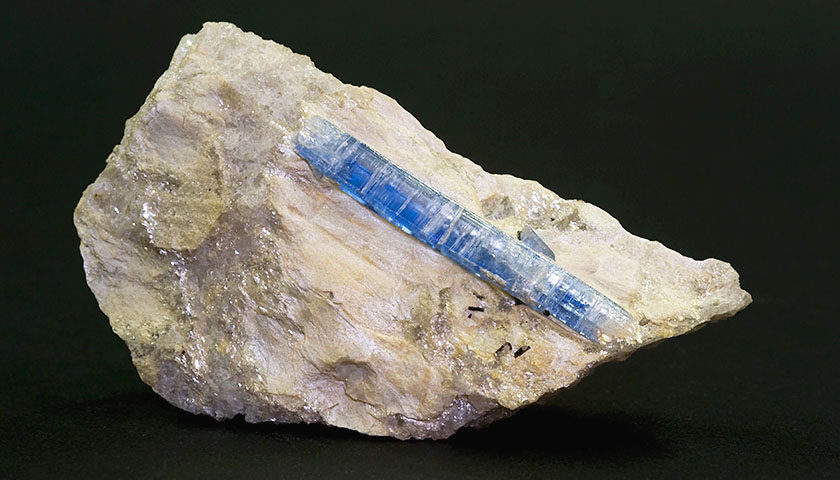
Much like us, kyanite has its preferred habitats. It’s often found in Manhattan schist, a rock formed under extreme pressure during the assembly of the supercontinent of Pangaea. You can also find kyanite hanging out in the Appalachian Mountains and in Minas Gerais, Brazil, as well as at Pizzo Forno in Switzerland. In Tanzania, it even sports an unusual orange color due to small amounts of manganese in its structure.
Gem-quality kyanite can be found around the world, from the United States (notably Connecticut, Georgia, Massachusetts, and North Carolina) to Brazil, Kenya, Mozambique, Switzerland, and more. Each location gives the kyanite a unique touch, further enhancing its charm and appeal.
Kyanite Use as a Gemstone
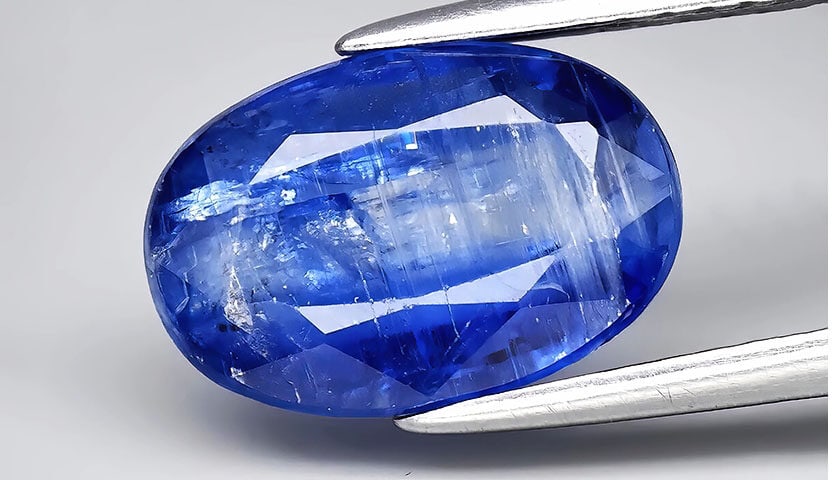
If you’ve ever stepped into an artisan jewelry store, or one associated with a mineral dealer, you might have had the pleasure of encountering an often-overlooked gem: kyanite. As a gemstone, kyanite might not be the first one to cross your mind, but its rarity and exotic appeal make it a captivating choice for those in the know.
Kyanite may not boast the fame of diamonds or the ubiquity of amethyst, but its lesser-known status gives it an air of intrigue. Its scarcity in standard jewelry stores is, in fact, what makes it so interesting and desirable.
Imagine donning a piece of kyanite jewelry. You’re not just wearing a gem; you’re wearing a story, a conversation starter. There’s a certain thrill that comes with explaining to an admirer that the stunning stone catching their eye is, indeed, the elusive kyanite.
Artistry and Challenges in Cutting Kyanite
When polished and cut to perfection, high-quality and brilliantly colored kyanite can be transformed into stunning cabochons and faceted stones. These gems lend themselves beautifully to rings, earrings, pendants, and other types of jewelry. Kyanite’s natural form, typically occurring in thin blades, also makes it a favorite for creating unique, flat geometric beads.
However, kyanite is not without its challenges. For one, it’s a notoriously tough mineral to cut. Why? Because kyanite exhibits two distinctly different hardnesses. Its crystals are typically long, narrow blades. They have a hardness of about 4.5 parallel to their length but a hardness of 6.5 to 7.0 across the width of the blade. Thus, skilled and patient cutters are needed to tackle this mineral.
The Sapphire Doppelgänger
There’s been a buzz in the gem world about kyanite being a lookalike for blue sapphire. And indeed, some specimens do display comparable colors. However, trained gemologists can readily tell them apart. Sapphire and kyanite have different refractive indices, optic character, and specific gravity values. Not to mention, kyanite’s hardness values also differentiate it from sapphire.
Of course, if you’re considering a kyanite as a sapphire substitute, please remember that kyanite is less durable than sapphire, though also much less expensive, giving it a certain advantage for those who appreciate both beauty and value.
The Tale of Synthetic Kyanites
In the gemstone world, there are often attempts to synthetically create sought-after gems. In the case of kyanite, scientists in the 1970s successfully synthesized it for research into its coloration. However, its challenging nature and the availability of natural kyanite make the prospects for a jewelry market for synthetic versions improbable.
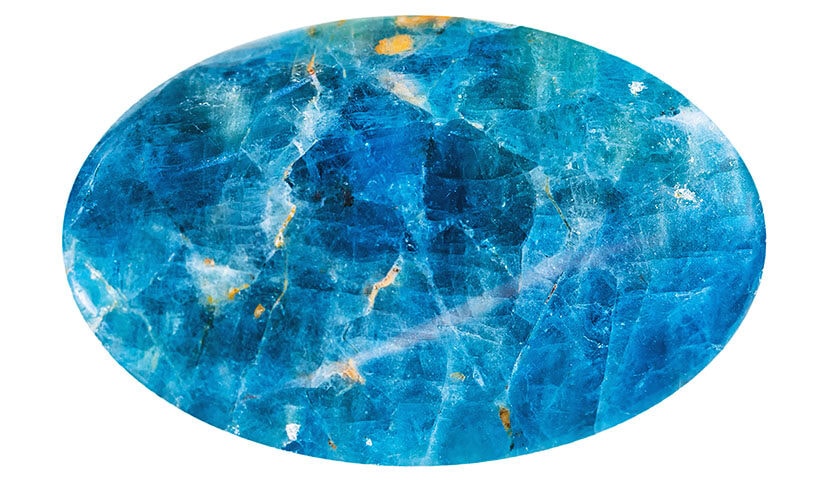
Yet, you might come across so-called “synthetic kyanites” for sale, especially as beads. Most likely, these are simply lookalikes rather than lab-created kyanites, instances of the term “synthetic” being used in the popular sense of “not real.”
Additionally, it’s worth noting that heating pale blue kyanites to 1,200º C may cause them to lose their color.
Kyanite: A Spectrum of Sizes
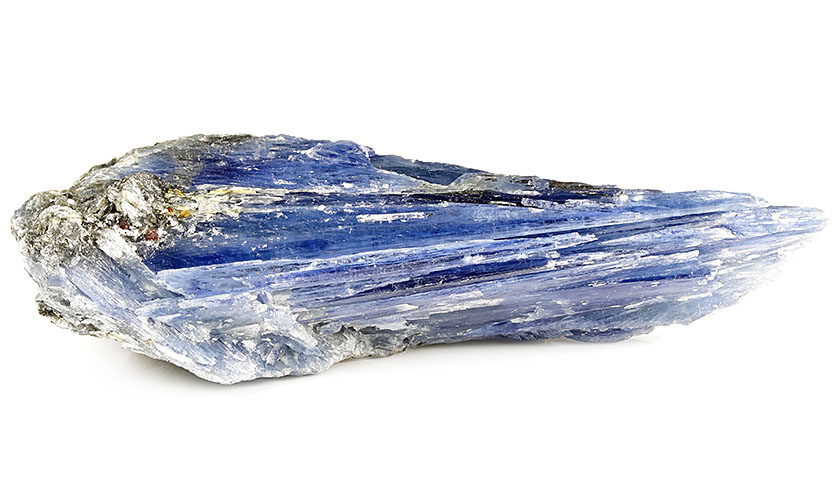
The size of kyanite stones can vary quite a bit, with faceters having cut gems up to about 20 carats. However, stones over 5 carats are seldom completely clean. Many of these larger gems are sourced from Brazil, with some coming from Africa.
Here are a few notable examples from collections around the world:
- Smithsonian Institution (Washington, DC): 10.7 (blue, Brazil); 9.1 (green, Brazil); 4.9 (blue, Tanzania).
- Private Collection: 6.57 (blue-green, North Carolina).
- Devonian Group (Calgary, Alberta, Canada): 14.0 (blue, Africa); 8.55 (blueish, Africa).
- Royal Ontario Museum (Toronto, Ontario, Canada): 40.26, 12.38 (rectangular step-cut, Brazil).
Kyanite’s appeal lies not just in its striking beauty, but also in its exotic rarity. Each piece of kyanite jewelry tells a story of artisanal craftsmanship and geological wonder, a conversation just waiting to be sparked.
Different Types of Kyanite
1. Blue Kyanite
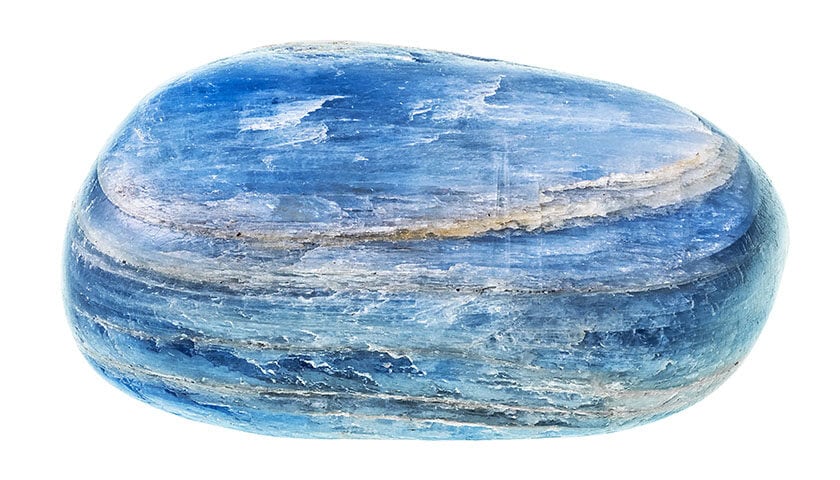
Blue kyanite is arguably the most recognized among this family of minerals. Its color ranges from light azure to deep indigo, capturing the tranquil essence of the sky and sea. Structurally, it’s known for its blade-like crystals, long and flat, which are indicative of its triclinic crystal system. These blue specimens are often found in metamorphic rocks, specifically in high-pressure and medium-temperature environments.
2. Black Kyanite
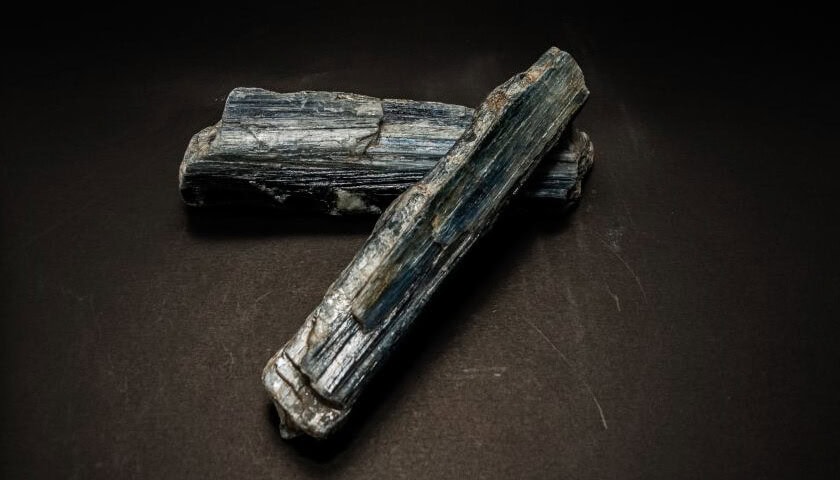
Black kyanite stands unique with its fan-like clusters. Its morphology resembles bird feathers, offering a distinctive aesthetic. This variety of kyanite is typically found in granular or massive forms, adding a unique textural component to this mineral family. This kyanite variant is found in metamorphic rocks and is known for its perfect cleavage, making it a unique object of study.
3. Green Kyanite
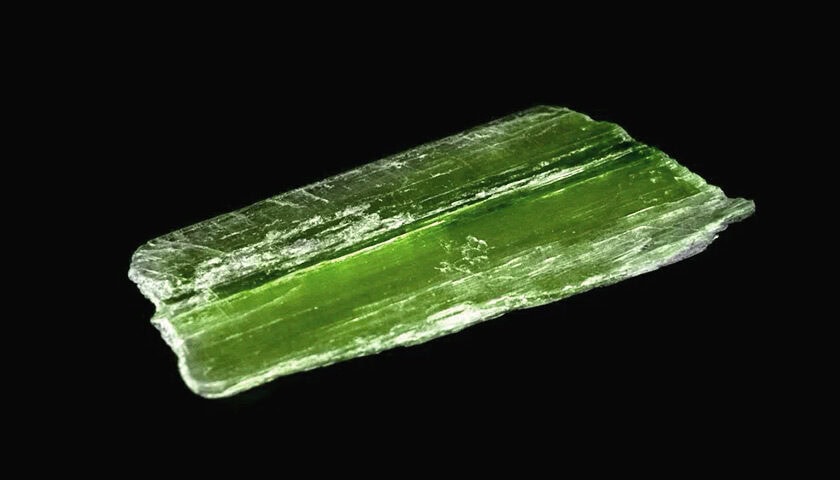
Green kyanite radiates a diverse spectrum of green hues, from light lime to a dark emerald, often accompanied by a hint of blue. Its occurrence is linked to metamorphic rocks, particularly schist and gneiss that underwent medium-grade metamorphism. Its physical properties closely resemble that of its blue counterpart, often appearing in elongated, blade-like crystals.
4. Ruby Kyanite
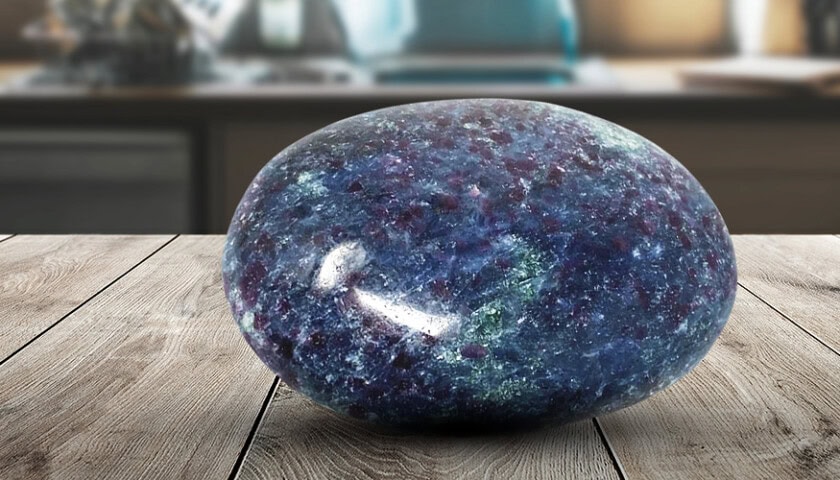
Ruby kyanite offers a stunning blend of two distinct mineral types, ruby and blue kyanite. This blend is visually appealing and fascinating from a geological standpoint. Both ruby and kyanite are alumina-rich minerals, but their formation environments are usually quite different, making this natural combination a rare and exciting find.
5. Orange Kyanite
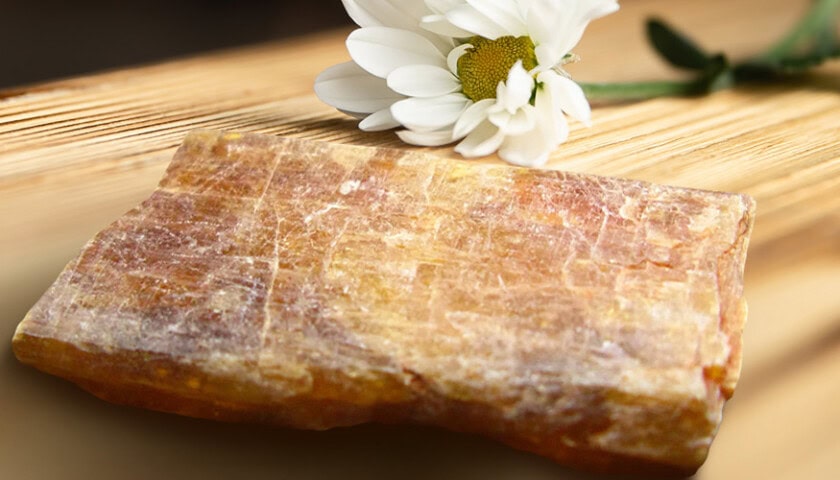
Orange kyanite is less common and comes with a unique geochemical signature. Like other varieties, it belongs to the triclinic crystal system, but its distinctive color is a result of small amounts of manganese, giving it its characteristic sunset hues.
6. White Kyanite
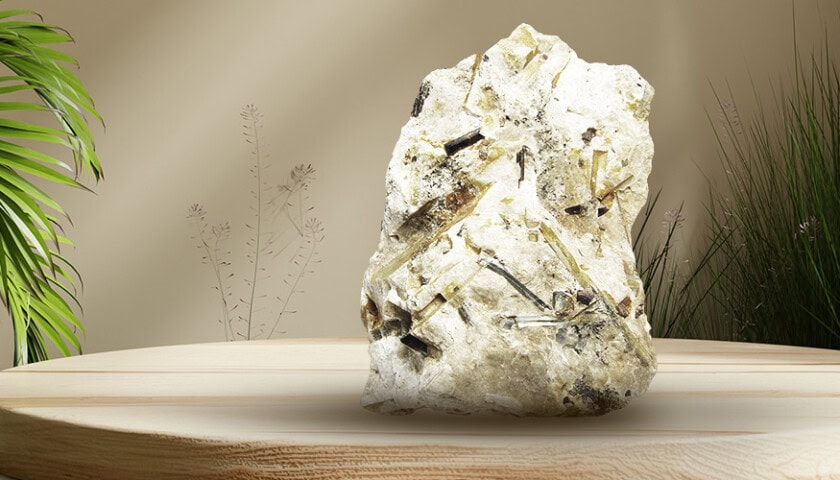
White kyanite often comes with an opaque to translucent appearance, frequently streaked with blue or green. Its occurrence is linked to high-grade metamorphic environments and pegmatites. Like other kyanites, it has perfect cleavage and displays anisotropic hardness, a feature that makes this mineral particularly unique.
7. Yellow Kyanite
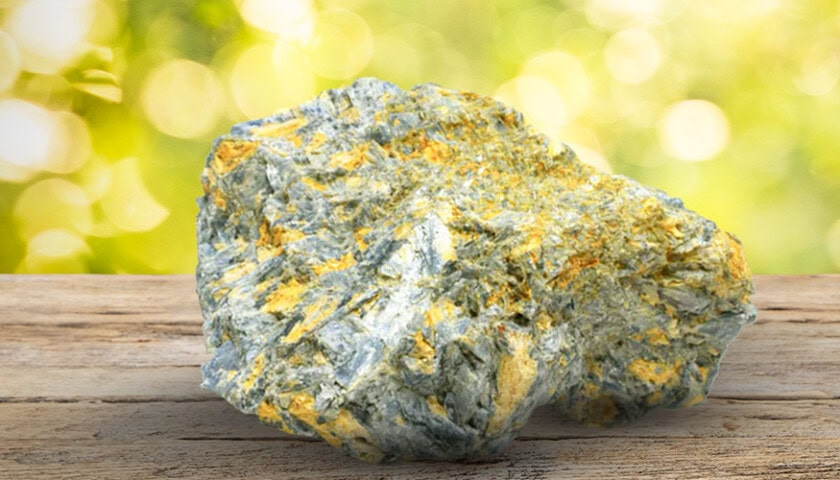
Yellow kyanite, varying from pale lemon to rich golden yellow, has a positive, sunlit energy about it. Geologically, it shares many properties with the blue variety, such as its anisotropic hardness and perfect cleavage. Its distinctive color is thought to be due to the presence of iron impurities.
8. Pink Kyanite
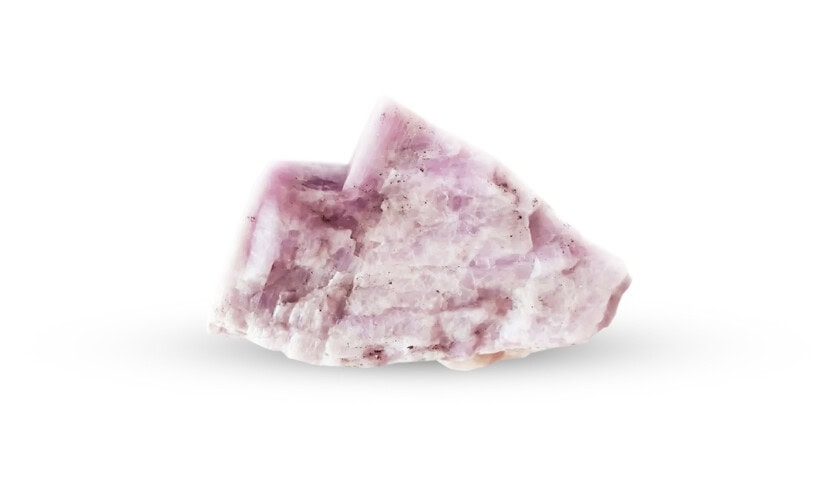
Pink kyanite is a rare variant of this mineral, often exhibiting colors from faint blush to rose. Its formation is similar to other kyanite varieties, frequently found in high-pressure, medium-temperature metamorphic environments.
9. Indigo Kyanite
Indigo kyanite, with its deep blue-violet color, is often associated with the infinite cosmos. It shares the same general geological properties with other kyanites, most notably its hardness variation depending on the crystallographic direction.
10. Purple Kyanite
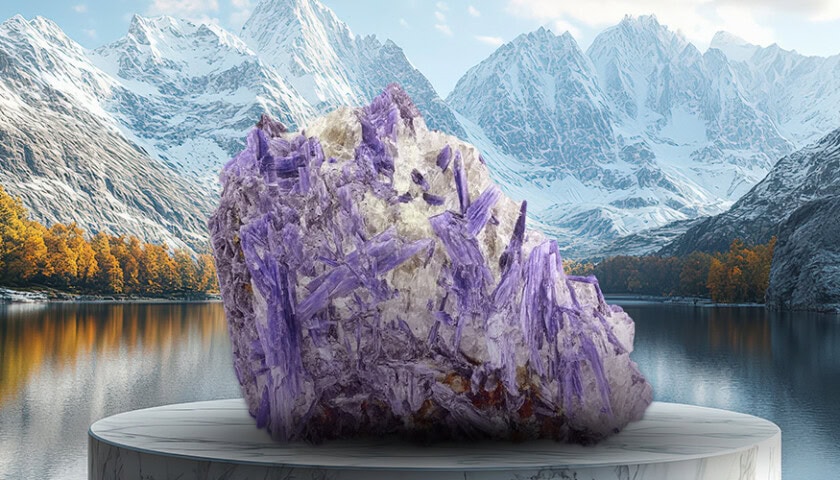
Purple kyanite, with its enchanting violet hues, shares its geological properties with blue kyanite but displays an unusual coloration, thought to be the result of trace elements or radiation-induced color centers.
11. Rainbow Aura Kyanite
Rainbow Aura Kyanite, an exquisite gemstone also known as Dichroic Kyanite, Kyanite Aura Peacock, or Kyanite Peacock Aura, is truly a sight to behold. Its vibrant, iridescent colors that span the full spectrum of a peacock’s plumage set it apart in the world of gemstones. Each specimen exhibits a unique, geometric pattern akin to an elegant fan, with facets that reflect light in a multitude of directions. The resulting dance of light, which changes as you move the gemstone, is truly mesmerizing. The fascinating color spectrum of Rainbow Aura Kyanite is not a natural phenomenon but the result of a special titanium treatment. This method closely resembles the process used to create Quartz Aqua Aura. As the Kyanite is heated, a fine layer of titanium is bonded to its surface, resulting in an iridescent, rainbow-like effect. The brilliance of the titanium enhances the inherent beauty of Kyanite, while also adding a layer of depth and intrigue. Rainbow Aura Kyanite’s energy is believed to be associated with the indigo and cyan rays on both sides, according to crystal healing practitioners. This gemstone is more than just a beautiful object; for many, it is a source of energy and inspiration.
Kyanite Meaning and Symbolism
The allure of kyanite transcends its physical beauty. This gemstone carries with it profound meaning and symbolism, resonating with a deep sense of peace and alignment. Its striking blue shades evoke the serenity of the sea and the expansiveness of the sky, acting as a calming beacon amidst the chaos of life.
Kyanite is often considered a stone of connection, believed to forge bridges of understanding between seemingly disparate ideas or people.
Like the intertwining roots of a forest, kyanite’s energy weaves together our fragmented thoughts, fostering unity of mind and purpose.
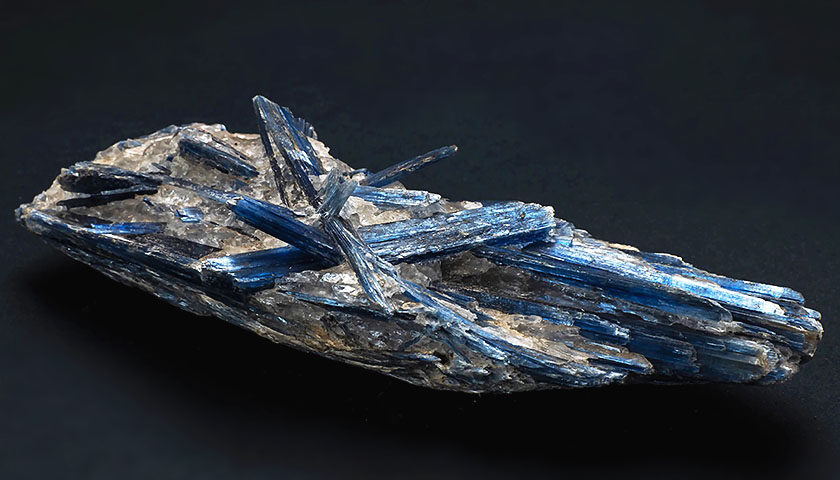
Have you ever tried to catch your breath on a busy day, yearning for a moment of tranquility amidst the hustle and bustle? Think of kyanite as a portable sanctuary, an oasis of serenity that you can carry with you. Just as a lighthouse guides lost ships safely to harbor, kyanite’s calming presence is said to gently steer us back when we drift away from our inner equilibrium.
Kyanite’s magic extends further, symbolizing healing and protection. Like a shield of energy, kyanite is believed to ward off negativity, creating a safe space for our spirits to rejuvenate and thrive.
Kyanite Healing Properties

Kyanite’s Emotional Healing
Imagine a serene azure sea washing over your tumultuous feelings, smoothing out emotional crests and troughs. That’s the soothing, cooling touch of kyanite. This enigmatic gem has been cherished for its unique ability to calm the mind, encouraging emotional tranquility. It’s like a trusty anchor in the storm, helping you remain steady and balanced amidst life’s turbulent currents. From quelling anger to dissolving frustration, kyanite’s soothing vibes work like a heartfelt lullaby for your emotional wellbeing.
If you’ve ever felt stuck in a cycle of negativity, Kyanite’s here to help break that pattern. It’s a beacon of light in the dark, a symbol of hope and perseverance. It encourages self-expression and communication, helping you to speak your truth openly and fearlessly. So, if you’re harboring any unexpressed feelings, this radiant gem may just help you find your voice.
Kyanite’s Spiritual Healing: A Soulful Awakening
On the spiritual plane, Kyanite is akin to a cosmic lighthouse, guiding you on your inner journey. This spiritual compass is said to awaken the higher mind, opening the door to greater intuition. Kyanite is a powerful tool for meditation, helping you reach deep states of relaxation and promoting profound insights. Its tranquil blue energy helps you connect with the present moment, grounding you in the ‘now’, reminding you that every moment of life is worthy of celebration.
Envision Kyanite as a bridge, a link between mind and spirit. It’s believed to aid in astral travel, dream recall and connecting with your spirit guides. This stunning gemstone is your spiritual passport, ready to help you embark on an extraordinary inward journey.
Kyanite’s vibrant energy also brings about an aura of protection, shielding you from negative energy. Imagine it as a guardian angel, its radiant blue light enveloping you, warding off any harmful vibrations and fostering a safe spiritual exploration.
Kyanite Metaphysical Properties

Kyanite is an extraordinary gemstone, celebrated not only for its enchanting beauty but for its profound metaphysical properties. It’s like a celestial tool, finely tuned to align all chakras, clear energetic pathways and meridians, thereby restoring Qi to the physical body. Let’s take a deeper look at how this captivating crystal influences various chakras, and the magical impact it has on our being.
Kyanite: The Harmonizer of Chakras
Kyanite’s energy is akin to a symphony conductor, orchestrating a seamless harmony among all chakras and subtle bodies. It creates a calmness that permeates the whole being, like the serene stillness after a storm. With its dual hues of blue and indigo, Kyanite works wonders on the Throat and Third Eye Chakras, enhancing communication and psychic awareness across all realms.
Kyanite and the Throat Chakra: Expressing Your Inner Truth
Imagine the Throat Chakra as the body’s vocal orchestra, a beautiful medium through which energy from other chakras is melodiously expressed. This energy center acts as a pressure valve, ensuring an open pathway for the expression of our thoughts and feelings. Like a faithful scribe, it brings our personal truths into the world.
When the Throat Chakra is out of balance or blocked, it hinders the other chakras’ vitality. But when it’s balanced and open, it allows for free expression and a smooth flow of energy within the body and spirit. It’s here that Kyanite, with its spectrum of blue energies, steps in, breaking any blockages and balancing the Throat Chakra. The darker shades of blue fuel the power of truth, while the lighter shades imbue flexibility, relaxation, and balance.
Kyanite and the Third Eye Chakra: The Seat of Perception
Let’s travel higher, to the Third Eye Chakra, also known as the Brow Chakra. It’s the captain of our perception and command, the very compass that guides our everyday awareness. It’s in this chakra that our consciousness resides, and it’s through this energy center that we connect with our own selves.
The Third Eye Chakra commands the body’s energy flow, distinguishing the meaningful from the mundane. When in balance, we see clearly, interpret visual cues with ease, and our thought processes are vibrant and healthy. We’re open to new ideas, dreams, and visions, and can control the flow of energy within all chakras. Kyanite, with its mysterious indigo hues, treats any imbalances, ushering wisdom and judgement.
Green Kyanite and the Heart Chakra: Harmony of Emotions
Green Kyanite is a beautiful ambassador of truth, connecting us to the sincerest emotions of the heart. Nestled near the center of the breastbone, the Heart Chakra governs our interaction with the outside world. This energy center controls what we embrace and resist, giving us the equilibrium to be ourselves. Green Kyanite, with its refreshing energy, resolves any blockages and rebalances the Heart Chakra. It helps us understand our own needs and emotions clearly, allowing us to navigate the turbulent seas of emotional relationships and embrace their cyclic nature.
Black Kyanite: Grounding and Energizing
Lastly, we have Black Kyanite, a versatile gemstone known to clear blocked energies in any chakra. This powerful stone is grounding yet invigorating, often linked with the Base Chakra at the spine’s base. This foundational chakra controls kinesthetic feeling and movement, serving as the bedrock for physical and spiritual energy.
How to Use Kyanite – A Guide to Harmonizing Your Life

Kyanite, a mesmerizing gemstone with intriguing metaphysical properties, can be a profound companion in your journey towards spiritual growth and balanced living. Let’s embark on this voyage of understanding how to harness its energies in meditation, feng shui, and your personal life.
Meditating with Kyanite
Picture yourself seated comfortably in a quiet space, a piece of kyanite cradled in your hands. As you close your eyes, let the kyanite’s soothing energy guide you into a state of deeper awareness. It’s like having your own celestial GPS, guiding your mind towards tranquility.
Kyanite’s unique ability to align all the chakras and subtle bodies becomes a conduit during meditation. Its calming influence clears energetic pathways, immersing you in a state of mindfulness and tranquility. The energy of kyanite can help heighten your psychic abilities and communication, opening the portals to higher realms.
Infuse Harmony in Your Spaces: Kyanite and Feng Shui
Think of Feng Shui as the art of curating your living space to optimize the flow of energy. Now, imagine Kyanite as a handy Feng Shui tool that can harmonize and balance these energy streams.
Placing Kyanite in areas of your home or workspace where energy seems stagnant can stimulate positive vibes. Particularly, it is beneficial to place Kyanite near communication devices to help clear electromagnetic frequencies. This way, Kyanite not only amps up the aesthetic appeal but also infuses your space with its calming influence.
Inviting Balance into Your Everyday: Kyanite at Home and Work
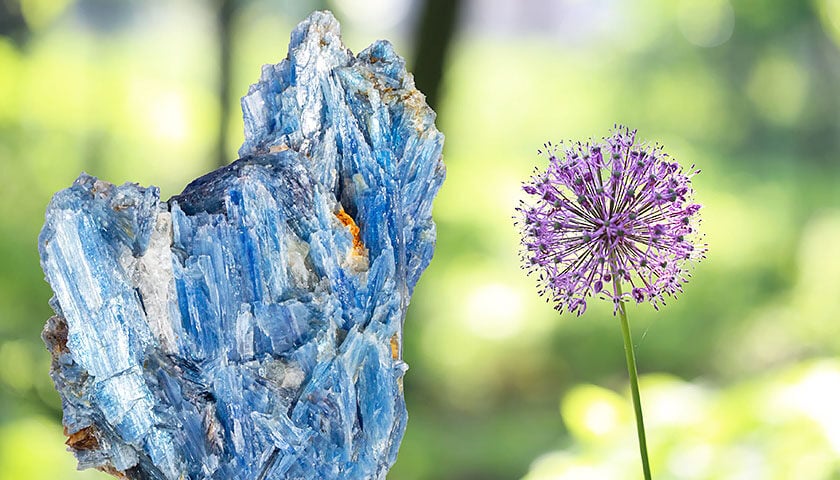
Kyanite isn’t just for meditation and Feng Shui; it can also be an everyday ally. Keep it in your pocket, place it on your desk, or use it as jewelry – there’s no limit to how you can bring this gemstone into your daily life.
At work, Kyanite can be a great stress-buster, its calming energies keeping the pressures at bay. If you’re someone who often participates in brainstorming sessions or creative discussions, keeping Kyanite close can bolster communication and inspire innovative ideas.
Ignite the Spark: Kyanite in Love and Relationships
Remember the excitement of a first date, the heart-pounding anticipation? Wouldn’t it be amazing if you could keep that spark alive in your relationships? Enter Kyanite, a gemstone known to facilitate open communication and understanding.
Having Kyanite close during heartfelt conversations can bring clarity and empathy, creating an environment for a stronger bond. Whether you’re looking to mend a misunderstanding or wanting to deepen the connection, Kyanite’s energy can be an invaluable support.
Wearing Kyanite Jewelry
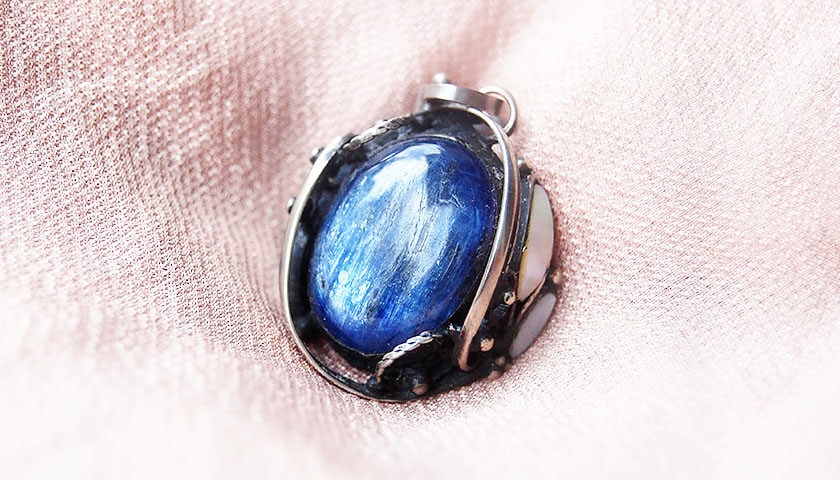
Kyanite jewelry isn’t just about enhancing your style statement; it’s about embracing a gemstone that carries a unique celestial energy. Let’s uncover the beauty and spiritual vibes these pieces can bring into your life.
Kyanite Necklaces: A Symphony at Your Heart
Imagine a vibrant, deep blue Kyanite necklace gracing your collarbone, its radiant hues complimenting your attire. Not only does it make heads turn, but the gemstone resting close to your heart also aligns your chakras, fostering an aura of calm and balance. It’s like wearing a protective talisman, infusing your day with tranquility and self-expression.
Kyanite Rings: Circle of Energy
Picture a stunning Kyanite ring on your finger. Its ethereal blue glow catches the light as you gesture, sparking conversations and admiring glances. But it’s not just about aesthetics; wearing a Kyanite ring can serve as a constant reminder of your commitment to inner harmony and spiritual growth. Every glance at your hand can serve as a moment of mindfulness.
Kyanite Bracelets: Embrace the Vibrations
Envision a delicate Kyanite bracelet encircling your wrist. Its vibrant beads dance with every movement, emitting a subtle, enchanting sparkle. But there’s more to this beautiful accessory. As you go about your day, the Kyanite beads stay in constant touch with your skin, their calming energy seeping into your aura, grounding you amidst the chaos of everyday life.
Kyanite Pendants: A Drop of Serenity
A Kyanite pendant can be an extraordinary piece, where style meets spirituality. Picture this pendant, its blue hue as profound as the night sky, hanging close to your heart. As a silent ally, it helps keep your emotions balanced, promoting an overall sense of well-being.
Kyanite Earrings: Whispering Winds
Think about a pair of Kyanite earrings, their gentle sway mirroring the calming effect of this gemstone. Every time you tuck a strand of hair behind your ear or catch a glimpse of yourself in the mirror, you’re reminded of the tranquility and inner harmony that Kyanite brings. It’s like carrying a whisper of serenity with you, wherever you go.
Kyanite Beads: A Strand of Tranquility
Kyanite beads, whether in a necklace, bracelet, or anklet, are not just ornamental. They’re like little pockets of tranquility, each bead holding the potential to align your chakras and bring peace to your aura. Imagine these beads, like constellations in a clear night sky, threading a path of calm and balance throughout your day.
Cleansing and Charging Your Kyanite
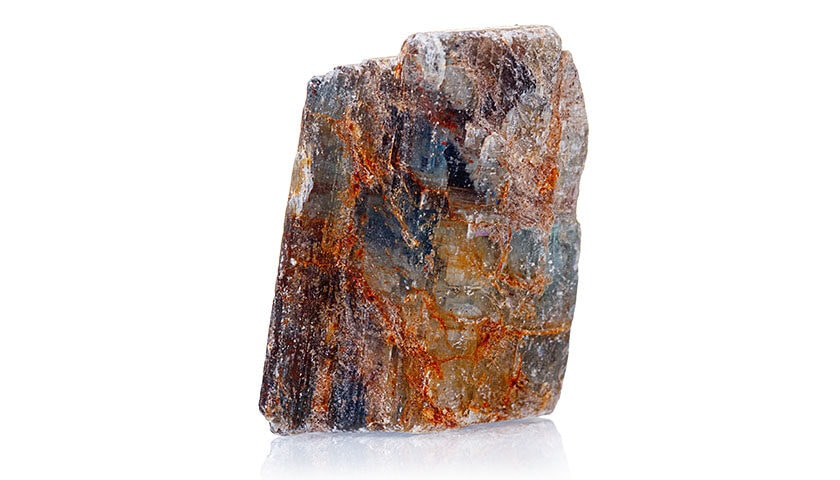
Revitalizing your Kyanite through cleansing and charging isn’t a laborious task—it’s a journey of rediscovery, bringing your crystal back to its energetic prime. Let’s journey through the mystical pathways of awakening the power within your Kyanite.
Sacred Smoke: Sage and Incense Cleansing
Envision sage’s sacred smoke swirling around your Kyanite, a cloud of purification. Or, perhaps, you’d like the aromatic power of incense to sweep over your gem, its fragrance paving the way for renewed energies. Whichever path you choose, these age-old cleansing techniques help revive your Kyanite’s vigor.
Embrace the Light: Sunlight and Moonlight Charging
Sunlight—it’s not just the life-giver to our world, but also a powerful energizer for your Kyanite. Imagine your crystal basking in sunlight, its blue hues shimmering, the sun’s rays injecting vitality. But don’t leave your gem out for too long; too much heat could lead to color fading.
Moonlight, on the other hand, offers a gentler approach. Visualize your Kyanite under a silvery moon, the lunar luminescence quietly charging your stone. The Full Moon night is especially potent, steeped in mystical lore, making it a fantastic time to charge your Kyanite.
Cherishing Your Kyanite: A Care Guide
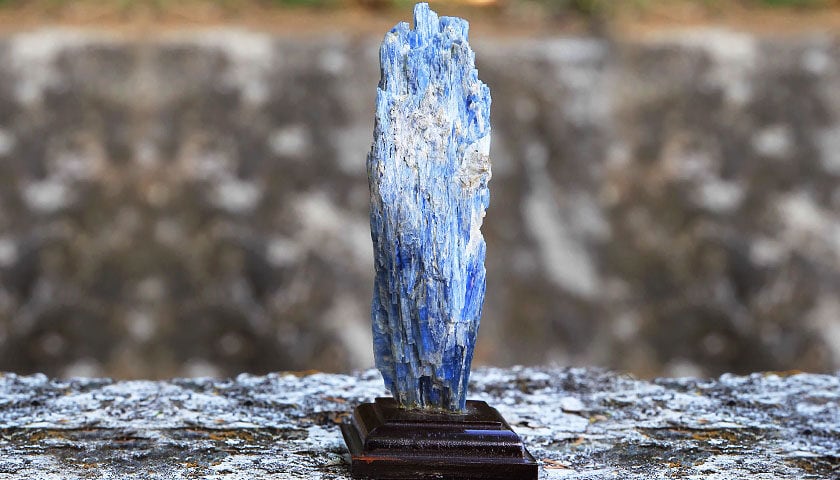
Owning a Kyanite crystal is like forging a timeless friendship. It’s a bond that grows stronger with care and love. So, let’s delve into how to best care for your Kyanite, ensuring its captivating charm and healing vibrations remain undiminished.
Keep it Cool: No to Extreme Temperatures
Imagine your Kyanite as a friend from a temperate climate, one who prefers mild weather over the extremes. So, if you’re thinking of steam cleaning your Kyanite jewelry, think again. The heat might unsettle your Kyanite’s harmonious energies, compromising its beauty and healing properties. So, when it comes to cleaning, stick to a mild soap solution and soft cloth.
Mind the Company: Away from Hard Gemstones
Kyanite, despite its mystical might, isn’t the toughest kid on the block. Harder gemstones might leave a mark on your Kyanite if kept in close contact. Think of it as a gentle soul, preferring the company of softer crystals, like Selenite or Calcite.
Shielding from Sunlight
Despite the allure of a sunlit gem, Kyanite isn’t a sun worshipper. Extended exposure to sunlight might fade its vibrant hues, diminishing its enchanting beauty. So, treat your Kyanite like a precious piece of artwork, protecting it from direct sunlight.
Home Sweet Home: Safe Storage
Just as you wouldn’t leave your cherished mementos carelessly strewn around, your Kyanite also deserves a safe and clean home. Dedicate a special space, perhaps a soft-lined jewelry box, where your Kyanite can rest, shielded from scratches and dust.
Kyanite Affirmations
An affirmation, in essence, is a positive statement that you declare to the universe as an absolute truth. It’s a tool to transform your mindset, to nurture a seed of thought into a blossoming reality. But affirmations aren’t magic spells that you utter and forget. They’re rituals of intention, requiring consistency and faith.

The crux of affirmations lies in their repeated practice, which convinces your subconscious mind to accept the desired outcomes as your reality. And as this conviction strengthens, you’ll notice a shift in your thoughts, attitudes, and behaviors, paving the way for your dreams to manifest into reality.
Kyanite and Affirmations: A Symbiotic Symphony
Now, you may wonder, what does Kyanite have to do with affirmations? Well, it’s all about energy. Just as affirmations are tools to shape your inner world, Kyanite is a gemstone that harmonizes your energetic realm.
Holding Kyanite during your affirmation rituals aids in aligning your chakras, the vital energy centers in your body. As Kyanite’s soothing vibes cleanse and balance these chakras, it creates a conducive environment for your affirmations to seep deeper into your subconscious. It’s like tilling the soil before sowing a seed—the better prepared the ground, the more robust the growth.
Crafting Your Kyanite Affirmations

When it comes to crafting your Kyanite affirmations, the mantra is simple—keep it personal, positive, and present tense. Here are some examples to inspire you:
- “I am harnessing Kyanite’s energy to align my chakras and achieve balance in my life.”
- “With Kyanite by my side, I am strengthening my communication and expressing myself authentically.”
- “I am using Kyanite’s calming energy to invite peace and tranquility into my life.”
When you say these affirmations, ensure you’re in a calm, focused state, preferably holding your Kyanite or wearing Kyanite jewelry. Feel the cool radiance of the Kyanite seeping into your skin, imagine its energy syncing with your chakras, and let your voice echo the words of your affirmation.
In this journey of manifesting with Kyanite affirmations, remember—there’s no space for doubts. You’re not hoping, you’re not wishing—you’re affirming. These aren’t future aspirations but present realities. Own them. Believe in them. And watch the magic unfold.
The path to self-improvement is a marathon, not a sprint. Keep at your affirmations with patience, perseverance, and unwavering belief. With every spoken word, you’re one step closer to your envisioned reality. And with Kyanite as your ally in this journey, that reality isn’t a distant dream—it’s within your grasp, waiting to materialize. So, embark on this exciting journey, let the power of affirmations transform your life, one positive thought at a time. And remember, you’ve got Kyanite by your side, amplifying your intentions and bridging your dreams with reality.
Unveiling Kyanite: A Spectrum of Shapes and Forms
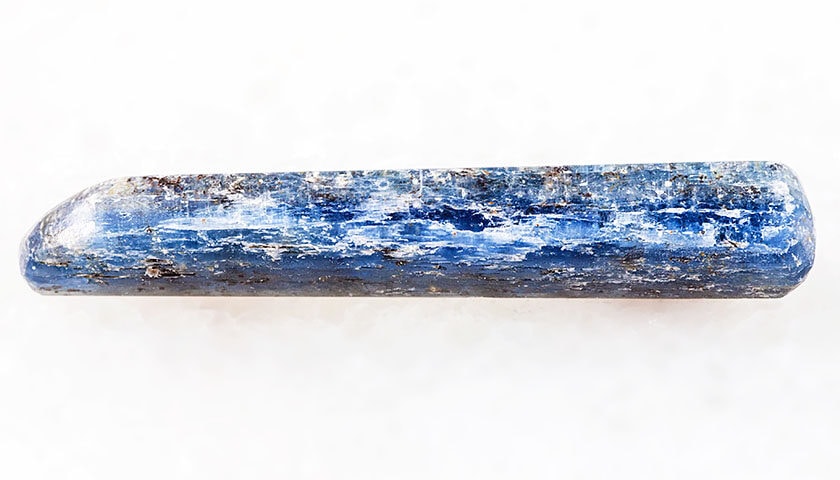
Dive into the magnificent world of Kyanite, where each shape and form resonates with a unique symphony of energies. From tumbled stones to palm stones, each form of Kyanite tells a story, inviting you to become a part of it. So let’s embark on this journey together, exploring the myriad shapes and forms of this splendid gemstone.
Kyanite Tumbled Stones
Kyanite tumbled stones are smooth, rounded pebbles, their raw edges softened by the tumbling process. Just like a river shapes pebbles, these stones have been ‘weathered’, inviting you to embrace life’s ebbs and flows. Hold one in your hand and feel its soothing energies fill you with tranquility.
Kyanite Polished Stones
Polished Kyanite stones carry a high shine, their surfaces mirror-smooth. As they catch the light, they serve as a metaphor for self-reflection, urging you to shine brightly in your authentic glory. Imagine the polished surface as a mirror reflecting your inner self – perfect in all its imperfections.
Kyanite Rough Stones
Rough Kyanite stones are unaltered expressions of the gem’s pure essence. Their rugged surfaces and natural crevices symbolize authenticity and raw potential. Embrace a rough Kyanite stone, and let it inspire you to honor your true, unadulterated self.
Kyanite Spheres
The sphere represents wholeness, unity, and infinity. A Kyanite sphere radiates its energy uniformly in all directions, creating a cocoon of its soothing vibes around you. Imagine this sphere as a miniature universe, radiating cosmic energy right in your palms.
Kyanite Hearts
Heart-shaped Kyanite is a symbol of love and emotional harmony. Let this stone remind you of the infinite capacity of your heart to love and heal. Holding a Kyanite heart, feel the pulsating love and compassion it inspires within you.
Kyanite Pyramids
Pyramids are believed to concentrate energy through their apex. A Kyanite pyramid is a potent tool to direct the crystal’s energy, helping to achieve a focused intent. Imagine the pyramid as a conduit between you and the cosmos, its peak channeling cosmic energy into your being.
Kyanite Wands
Long, cylindrical Kyanite wands direct and channel the stone’s energy. Use one to guide healing energy towards specific areas in your body or space. Visualize the Kyanite wand as a magic staff, guiding and directing energies at your will.
Kyanite Palm Stones
Shaped to fit comfortably in your hand, Kyanite palm stones are companions of serenity. Let their soothing vibes seep into your skin as you meditate or stress-release. Hold a palm stone and imagine its tranquil energy melting your worries away.
Kyanite Cabochons
Cabochons are polished, non-faceted gems, usually with a domed top and flat bottom. Kyanite cabochons, with their smooth finish and vibrant sheen, are where art meets energy. Picture a cabochon as a canvas, its surface telling a unique story of Kyanite’s journey from the earth to your hands.
Exploring Kyanite Crystal Combinations
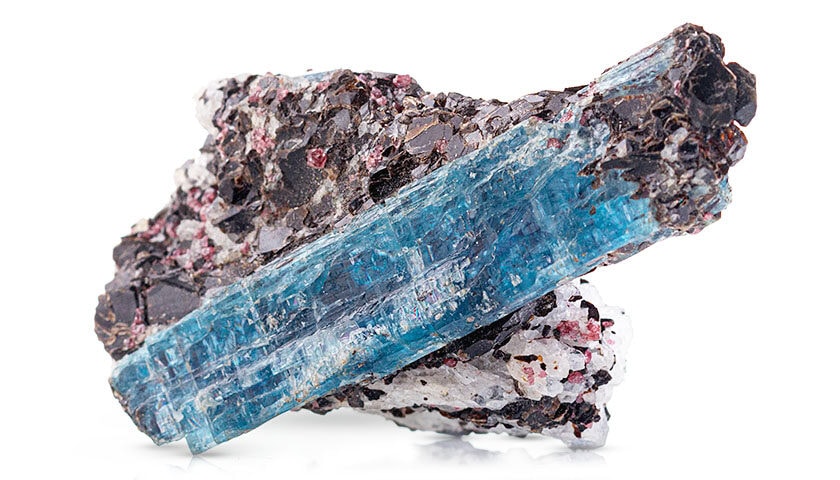
Kyanite and Labradorite: Harmony in Blues
Picture the meeting of two powerful storms, a beautiful clash of celestial forces—That’s what happens when you combine Kyanite and Labradorite. Labradorite’s ability to unleash inner potentials pairs wonderfully with Kyanite’s throat chakra alignment. Together, they create a cascade of inspiration, boosting communication and encouraging self-expression. Keep this duo close when you’re brainstorming or need a dash of creativity.
Kyanite and Tourmaline: Balancing Act
When Kyanite meets Tourmaline, it’s like striking a perfect chord on a grand piano. Tourmaline, with its grounding force, offers balance to Kyanite’s high-frequency vibes. If you’re feeling scattered or overwhelmed, this dynamic duo brings you back to center, grounding and calming you while enhancing your clarity and awareness.
Kyanite and Garnet: Passion Ignites
Ever tried lighting a bonfire on a frosty night? That’s the energy surge you’ll experience with Kyanite and Garnet. Garnet’s fiery nature sparks Kyanite’s soothing vibes, firing up your determination and zest for life. It’s the perfect pair when you need to light a fire under those dreams and goals.
Kyanite and Amethyst: Peaceful Dreams
Take a deep breath and let it out slowly. Feel the tranquility? That’s Kyanite and Amethyst for you. Amethyst’s spiritual properties, mixed with Kyanite’s alignment, bring a profound sense of peace and calm. This is your go-to combo for meditative practices or if you’re seeking respite from the hustle and bustle of life.
Kyanite and Aquamarine: Emotional Waves
Imagine you’re at the beach, letting the waves lap at your feet. That’s what Kyanite and Aquamarine feel like together. Aquamarine’s calming energy echoes in Kyanite’s tranquil vibes, creating an ocean of emotional clarity and intuitive awareness. When you’re navigating emotional storms, this pairing is your beacon in the dark.
Kyanite and Selenite: Ethereal Glow
It’s like stargazing on a clear night; that’s the mystical connection between Kyanite and Selenite. Selenite’s lunar energy augments Kyanite’s alignment abilities, connecting you to higher realms of consciousness. For spiritual exploration or astral travels, hold onto this celestial pair.
Kyanite and Sodalite: Voices Unleashed
Picture a duo belting out a soul-stirring melody. That’s Kyanite and Sodalite—harmonizing to help you find your voice. Sodalite’s truth-enhancing qualities meet Kyanite’s communication prowess, encouraging authenticity and self-expression. Grab this pair when you need the courage to speak your truth.
Kyanite and Andalusite: Into the Earth
Imagine a seedling pushing through the earth, reaching for the sky—that’s Kyanite and Andalusite. Andalusite’s grounding essence combines with Kyanite’s uplifting energy, creating a stable yet dynamic atmosphere. This combination is great for when you’re seeking balance during life transitions.
Kyanite and Clear Quartz: Clear Visions
Ever had the sun break through the clouds just when you needed it? That’s Kyanite and Clear Quartz. Clear Quartz amplifies Kyanite’s attunement abilities, providing a clarity boost. Whether you’re seeking solutions or striving for spiritual growth, this dynamic duo will light your way.
Kyanite vs Sapphire
Kyanite and Sapphire, two of the most captivating gemstones on the market, bring together a fascinating palette of blues that intrigue the eye and ignite the imagination. Both gemstones are indeed blue in their most known form, but that’s just the tip of the iceberg of their deep and intriguing properties.
Kyanite, a fascinating gemstone, is known for its color range that varies from a near sapphire blue, indigo, and into a greenish-blue shade. What’s fascinating about Kyanite is its property of anisotropism – it exhibits different colors when viewed from different angles. This lends Kyanite a unique look that is full of surprises. Originating in metamorphic rocks, Kyanite can be found in locations such as Nepal, Brazil, and the United States. As of 2023, Kyanite is valued at around $50 – $100 per carat, making it an affordable option for gemstone enthusiasts.
On the other hand, Sapphire is the nonpareil of the gemstone world. Its rich, velvety blue hue is unrivaled and widely sought after. Sapphire is a variety of corundum and is incredibly hard, scoring a 9 on the Mohs scale, second only to diamond. This gemstone, unlike Kyanite, is often treated to enhance its color and clarity. Sapphires are mainly sourced from countries like Sri Lanka, Madagascar, and Myanmar. The price for a sapphire can vary greatly depending on its quality, but they generally range from $800 – $1,600 per carat.
When it comes to cultural significance, Sapphires have been revered for centuries, symbolizing nobility, truth, and faithfulness, which is why they are a popular choice for engagement rings. Kyanite, on the other hand, is known in crystal healing circles for its ability to align chakras and is thought to aid communication and self-expression.
Kyanite vs Tanzanite
The ethereal beauty of Tanzanite and Kyanite is awe-inspiring, with each stone flaunting a unique blue hue that resonates with the tranquillity of the seas and skies. Tanzanite, discovered in the Mererani Hills of Northern Tanzania, is treasured for its striking blue-violet color. The gemstone, a member of the zoisite family, shows pleochroism, meaning it exhibits different colors when viewed from different angles – typically a mix of purple, blue, and brown. Tanzanite’s price range is around $300 – $700 per carat, a reflection of its single-source origin and finite supply.
In comparison, Kyanite’s color palette feels softer, subtler, yet equally enchanting. Its distinguishing feature, anisotropism, sets it apart. However, unlike Tanzanite, Kyanite remains largely untreated, allowing its natural beauty to shine through. Both gemstones are known for their spiritual properties in crystal healing. Kyanite is considered a stone of tranquillity and calm, while Tanzanite is thought to aid in spiritual awareness and psychic insight.
Kyanite vs Blue Calcite
Blue Calcite, with its soothing, sky-blue tones, offers a stark contrast to the intense blue of Kyanite. As a carbonate mineral, Blue Calcite is softer than Kyanite, registering a 3 on the Mohs scale, while Kyanite ranges from 4.5 – 7 due to its anisotropic nature. The geographical sources of these gemstones are also diverse. Blue Calcite is plentiful and found in large deposits worldwide, while Kyanite’s significant sources are Nepal, Brazil, and the United States. Blue Calcite is relatively inexpensive, costing around $2 – $5 per carat.
Both gemstones are reputed to carry calming energies. Blue Calcite is believed to facilitate physical healing, while Kyanite is said to enhance communication and promote tranquillity. Each stone, in its own way, is a testament to the beauty and diversity of nature’s creations.
Kyanite vs Lapis Lazuli
Lapis Lazuli, the stone of kings and queens from history, shares the blue color with Kyanite. However, the intensity and depth of color differ significantly. Lapis Lazuli exhibits a deep, celestial blue that often sparkles with golden pyrite inclusions, while Kyanite presents a range of blue hues, sometimes even in a single specimen. Lapis Lazuli is slightly softer than Kyanite, scoring around 5 – 5.5 on the Mohs scale.
Lapis Lazuli has been a symbol of royalty, gods, and power since ancient times. It was used extensively in jewelry, decoration, and even cosmetics by the ancient Egyptians. In comparison, Kyanite’s cultural and historic significance is less prominent, but it is valued in the metaphysical realm for its calming and balancing properties.
Kyanite vs Labradorite
Comparing Kyanite with Labradorite is like comparing the tranquil blue sky with the mystic Northern lights. Labradorite, a feldspar mineral, is renowned for its iridescence, known as labradorescence, which showcases a play of colors. This is a far cry from Kyanite’s pure, serene blue. Labradorite can be found in countries such as Canada, Madagascar, and Finland, while Kyanite is primarily found in Nepal, Brazil, and the United States.
Labradorite is believed to be a stone of transformation and is thought to boost intuition. This aligns with Kyanite’s reputed properties of promoting communication and tranquillity. Labradorite is generally more affordable than Kyanite, with prices varying from $10 – $50 per carat.
Kyanite vs Sodalite
Lastly, we compare Kyanite to Sodalite. At first glance, both gemstones showcase enchanting blues. However, Sodalite often has characteristic white veins running through it, unlike the more uniformly colored Kyanite. Sodalite, scoring around 5.5 – 6 on the Mohs scale, is slightly softer than Kyanite.
Both Kyanite and Sodalite are considered powerful in crystal healing circles. Sodalite is known as a stone of truth, helping to improve communication, while Kyanite is revered for its ability to balance energy and promote tranquillity. In terms of cost, Sodalite is more affordable, with prices hovering around $1 – $10 per carat.
Kyanite vs Azurite
In the realm of fascinating blue gemstones, Kyanite and Azurite make a captivating duo. Azurite, with its deep, lustrous blue color, is indeed a stark contrast to the range of blue hues found in Kyanite. The copper carbonate mineral, Azurite, is softer than Kyanite, falling at about 3.5 to 4 on the Mohs scale. Significant sources of Azurite include the USA, Mexico, Namibia, Morocco, and Australia. In terms of value, Azurite’s price generally ranges from $20 to $50 per carat.
Azurite is famed for its association with deep intuition and spiritual insight, making it a staple in many metaphysical practices. Kyanite, with its reputation for balancing energies and promoting tranquillity, makes a compelling companion.
Kyanite vs Blue Apatite
Blue Apatite, with its distinctive ocean-like color, provides an interesting comparison to the serenity of Kyanite. Blue Apatite’s color is often more greenish-blue or teal compared to Kyanite’s more sapphire-like blue. Falling between 5 and 5.5 on the Mohs scale, Blue Apatite is slightly softer than Kyanite. Large deposits of Apatite are found in Russia, Canada, Mexico, and the USA. Blue Apatite is quite affordable with prices ranging from $2 – $10 per carat.
In the metaphysical realm, Blue Apatite is associated with communication and self-expression, a trait also associated with Kyanite, making them intriguing counterparts.
Kyanite vs Aquamarine
Aquamarine, a member of the beryl family, boasts a sea-like light blue color that sets it apart from Kyanite’s deeper blue. Aquamarine scores a solid 7.5 to 8 on the Mohs scale, making it a harder stone than Kyanite. Main sources of Aquamarine include Brazil, Nigeria, Zambia, Madagascar, and Ukraine. Depending on its quality, the price of Aquamarine can range from $60 to $1000 per carat.
Aquamarine is associated with the sea and is believed to be a soothing stone, similar to the calming properties attributed to Kyanite.
Kyanite vs Celestite
Next up is the comparison between Kyanite and Celestite, a gemstone known for its pale, celestial blue color, in stark contrast to the more vibrant blues seen in Kyanite. Celestite, with a hardness of 3 to 3.5 on the Mohs scale, is significantly softer than Kyanite. Major sources of Celestite include Madagascar, the USA, and Mexico. It’s relatively inexpensive, with prices ranging from $2 – $10 per carat.
Celestite is considered a stone of divine expression and is often associated with angelic or spiritual communication, which is a unique facet when compared to Kyanite’s reputation for balancing energy and promoting tranquillity.
Kyanite vs Blue Lace Agate
Blue Lace Agate, characterized by its soft, light blue color with white or light gray banding, presents a unique contrast to the varying shades of blue in Kyanite. Blue Lace Agate is a variety of Chalcedony, registering around 7 on the Mohs scale. It’s primarily found in Namibia and South Africa. The price of Blue Lace Agate can range from $2 to $20 per carat.
Blue Lace Agate is believed to be a soothing and nurturing stone, fostering communication and peace, which makes it an interesting comparison with the calming and balancing Kyanite.
Kyanite vs Dumortierite
Finally, let’s explore the comparison between Kyanite and Dumortierite, another blue-hued gemstone. Dumortierite’s color ranges from blue, brown, to green, and it often exhibits an interesting fibrous structure. It’s a fairly hard mineral, with a score of 7 on the Mohs scale. Major sources of Dumortierite include Brazil, the USA, France, and Sri Lanka. Dumortierite is generally inexpensive, with prices ranging from $1 – $10 per carat.
Like Kyanite, Dumortierite is believed to promote patience and calmness. Despite their differences, they both offer a sense of peace and balance, making them a fascinating pair to consider.
Frequently Asked Questions About Kyanite
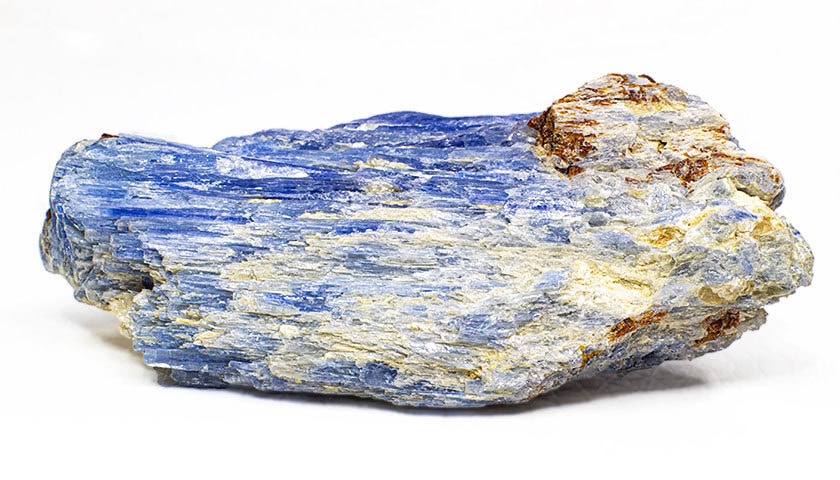
What is Kyanite?
Kyanite is a typically blue aluminosilicate mineral that’s found in metamorphic rocks. It can also occur in shades of green, yellow, orange and even black.
Where does Kyanite come from?
Significant deposits of Kyanite are found in locations such as Nepal, Brazil, the United States, Switzerland, and Austria.
What are the physical properties of Kyanite?
Kyanite is unique because it exhibits anisotropism, meaning it has different hardness on different axes. It scores between 4.5 – 7 on the Mohs scale.
How is Kyanite used in jewelry?
Due to its attractive color and high refractive index, Kyanite is commonly used in earrings, pendants, and decorative brooches. Its variable hardness makes it less ideal for rings.
Can Kyanite change color?
Kyanite’s color is usually stable. However, due to its anisotropic property, it can seem to display different colors when viewed from different angles.
How much does Kyanite cost?
The price of Kyanite can range from $50 – $100 per carat depending on factors such as color, clarity, and size.
Is Kyanite a birthstone?
Kyanite is not a traditional birthstone, but it’s often associated with the zodiac sign of Taurus.
What is the spiritual significance of Kyanite?
In crystal healing, Kyanite is believed to aid in communication, promote tranquillity, and align the chakras.
Does Kyanite fade in sunlight?
Unlike some gemstones, Kyanite is generally stable in sunlight and doesn’t fade easily.
Can Kyanite be used in engagement rings?
While Kyanite’s beauty makes it attractive for jewelry, its variable hardness and cleavage properties might not make it the best choice for everyday wear items like engagement rings.
Is Kyanite a rare gemstone?
Kyanite is not particularly rare but high-quality gem-grade Kyanite is less common.
What chakras is Kyanite associated with?
Kyanite is associated with the Throat and Third Eye chakras, although it can align all chakras.
Can Kyanite be used for Feng Shui?
Yes, Kyanite can be used in Feng Shui as a tool for clearing energy blockages and attracting positive energy.
Is Kyanite toxic?
Kyanite is not toxic. However, as with any mineral, it’s not advisable to ingest it.
Can Kyanite go in the water?
Yes, Kyanite can be cleaned and cared for with water. However, it should not be soaked for prolonged periods as this might affect its luster.
Is Kyanite magnetic?
No, Kyanite is not magnetic. It does not contain iron and therefore does not exhibit any significant magnetic properties.
Does Kyanite glow under UV light?
Kyanite does not typically show a strong reaction under UV light.
Can Kyanite be in the sun?
Kyanite is stable under sunlight and does not fade easily, so it’s generally safe to expose it to sunlight.
What’s the difference between Kyanite and Sapphire?
While both Kyanite and Sapphire can exhibit beautiful shades of blue, they are different minerals. Sapphire, a variety of corundum, is much harder (9 on the Mohs scale) compared to Kyanite. Sapphires are also usually more valuable.
What’s the difference between Kyanite and Tanzanite?
Tanzanite is a variety of the mineral zoisite and is typically a deeper, purplish-blue color, while Kyanite is typically lighter blue. Tanzanite is also found exclusively in Tanzania, while Kyanite deposits are found in various locations around the world.
What’s the difference between Kyanite and Lapis Lazuli?
Lapis Lazuli is a rock, not a mineral, composed of several minerals, mainly lazurite, calcite, and pyrite. Kyanite is a distinct mineral. Lapis Lazuli has a uniform deep blue color, while Kyanite varies from light to dark blue.
What’s the difference between Kyanite and Sodalite?
Sodalite is a rich royal blue mineral widely enjoyed as an ornamental gemstone. Unlike Kyanite, it is not pleochroic, and its color is usually more uniform. Kyanite is anisotropic, showing different hardness in different directions.
What’s the difference between Kyanite and Tanzanite?
Tanzanite, a member of the zoisite family, is typically a deep purplish-blue color and is found exclusively in Tanzania. Kyanite, on the other hand, is typically lighter blue and can be found in various locations around the world.
What’s the difference between Kyanite and Celestite?
Celestite is a mineral with a pale, celestial blue color, in contrast to the deep blues often seen in Kyanite. Celestite is also much softer (3 – 3.5 on the Mohs scale) than Kyanite.
| Kyanite Physical Properties | |
|---|---|
| Crystal Structure | Triclinic |
| Mineral Class | Silicates |
| Specific Gravity | 3.53 – 3.65 |
| Formula | Al2SiO5 |
| Hardness | 4.5 – 7 |
| Transparency | Transparent to translucent |
| Chemical Composition | Aluminium silicate |
| Locations | Brazil, USA, Switzerland, Russia, Nepal, Italy |
| Rarity | Common |
| Can Be Submerged in Water | Yes, but it’s not recommended for long periods |
| Sun Safe Crystal | Yes, but prolonged exposure may lead to slight fading |
| Special Care Instructions | Avoid high heat, harsh chemicals, and don’t soak in water. Store separately to avoid scratching by harder gems. |
| Price/Carat | $5 – $100 (Note that the price per carat can vary widely depending on the quality and size of the stone, as well as its origin and treatment status.) |
| Kyanite Metaphysical Properties | |
|---|---|
| Chakras | Throat, Third Eye, Aligns All |
| Zodiac Signs | Libra, Aries, Taurus |
| Planets | Neptune, Venus |
| Numerical Vibration | 4 |
| Elements | Air, Water |
| Symbolism | Inner Bridges, Psychic Ability, Connection, Communication, Healing |
| Birthstones | Taurus (secondary birthstone) |
| Affirmations | “I receive and communicate my truest thoughts with clarity.” |
| Emotional Conditions | Anxiety, Stress, Fear, Panic, Confusion, Communication |
| Spiritual Purposes | Astral Projection, Meditation, Attunement, Dream Recall, Connecting with Spirit Guides |
| Crystal Combinations | Labradorite, Tourmaline, Garnet, Amethyst, Aquamarine, Selenite, Sodalite, Andalusite, Clear Quartz |

